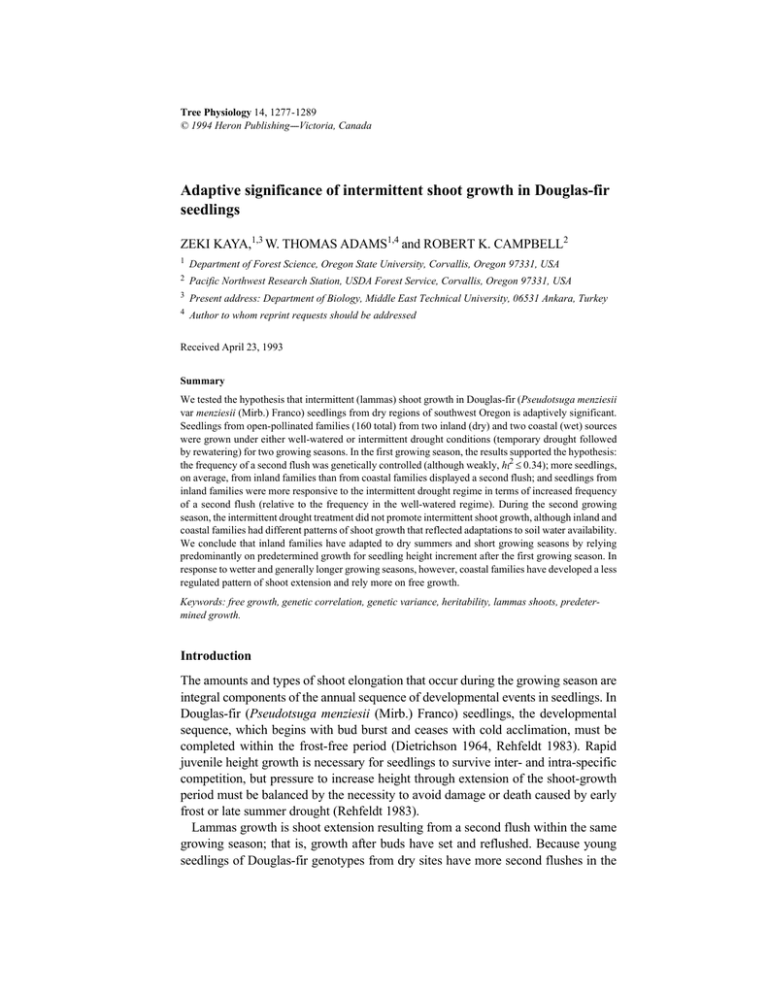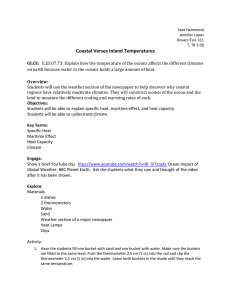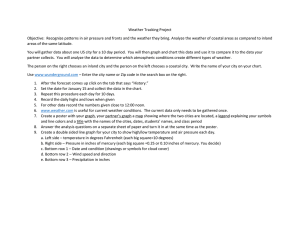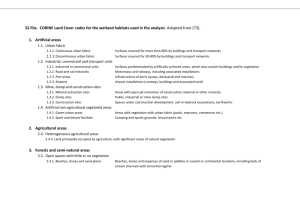Adaptive significance of intermittent shoot growth in Douglas-fir seedlings ZEKI KAYA,
advertisement

Tree Physiology 14, 1277-1289 © 1994 Heron Publishing----Victoria, Canada Adaptive significance of intermittent shoot growth in Douglas-fir seedlings ZEKI KAYA,1,3 W. THOMAS ADAMS1,4 and ROBERT K. CAMPBELL2 1 Department of Forest Science, Oregon State University, Corvallis, Oregon 97331, USA 2 Pacific Northwest Research Station, USDA Forest Service, Corvallis, Oregon 97331, USA 3 Present address: Department of Biology, Middle East Technical University, 06531 Ankara, Turkey 4 Author to whom reprint requests should be addressed Received April 23, 1993 Summary We tested the hypothesis that intermittent (lammas) shoot growth in Douglas-fir (Pseudotsuga menziesii var menziesii (Mirb.) Franco) seedlings from dry regions of southwest Oregon is adaptively significant. Seedlings from open-pollinated families (160 total) from two inland (dry) and two coastal (wet) sources were grown under either well-watered or intermittent drought conditions (temporary drought followed by rewatering) for two growing seasons. In the first growing season, the results supported the hypothesis: the frequency of a second flush was genetically controlled (although weakly, hf2 £ 0.34); more seedlings, on average, from inland families than from coastal families displayed a second flush; and seedlings from inland families were more responsive to the intermittent drought regime in terms of increased frequency of a second flush (relative to the frequency in the well-watered regime). During the second growing season, the intermittent drought treatment did not promote intermittent shoot growth, although inland and coastal families had different patterns of shoot growth that reflected adaptations to soil water availability. We conclude that inland families have adapted to dry summers and short growing seasons by relying predominantly on predetermined growth for seedling height increment after the first growing season. In response to wetter and generally longer growing seasons, however, coastal families have developed a less regulated pattern of shoot extension and rely more on free growth. Keywords: free growth, genetic correlation, genetic variance, heritability, lammas shoots, predeter­ mined growth. Introduction The amounts and types of shoot elongation that occur during the growing season are integral components of the annual sequence of developmental events in seedlings. In Douglas-fir (Pseudotsuga menziesii (Mirb.) Franco) seedlings, the developmental sequence, which begins with bud burst and ceases with cold acclimation, must be completed within the frost-free period (Dietrichson 1964, Rehfeldt 1983). Rapid juvenile height growth is necessary for seedlings to survive inter- and intra-specific competition, but pressure to increase height through extension of the shoot-growth period must be balanced by the necessity to avoid damage or death caused by early frost or late summer drought (Rehfeldt 1983). Lammas growth is shoot extension resulting from a second flush within the same growing season; that is, growth after buds have set and reflushed. Because young seedlings of Douglas-fir genotypes from dry sites have more second flushes in the 1278 KAYA, ADAMS AND CAMPBELL first growing season than genotypes from wet sites, several authors have suggested that the capacity for a second flush is an adaptation of sources from dry sites to intermittently favorable water conditions during the growing season; that is, an ability to cease growth during periods of drought and to resume growth when soil water becomes available (Irgens-Moller 1967, Lavender and Overton 1972, Griffin 1974, Loopstra 1984). Although patterns of conifer shoot growth have been extensively studied (Shaw 1914, Romberger 1963, Kozlowski 1964, Jablanczy 1971, Van Den Berg and Lanner 1971, Cannell et al. 1976, Lanner 1976, Ununger et al. 1988, Ekberg et al. 1991), there have been few studies of seedling shoot-growth patterns in Douglas-fir (Irgens-Moller 1967, Lavender and Overton 1972, Griffin 1974, Loopstra 1984, White 1987, Kaya et al. 1989). Generally, two modes of shoot growth in conifers are recognized: predetermined and free growth. Predetermined growth is the elongation of the primordial shoot contained in the overwintering bud (Romberger 1963, Pollard and Logan 1974, Halle et al. 1978), whereas free growth is shoot growth resulting from the initiation and elongation of needle primordia without formation of an intermediate overwintering bud (Jablanczy 1971). Consistent with this definition, all shoot growth in the first growing season after germination is free growth (Lanner 1976, Ununger et al. 1988). Any free growth in growing seasons after the first year, however, is preceded by predetermined growth and occurs with or without the formation of a resting bud (von Wuchlisch and Muhs 1986, Kaya et al. 1989). In this paper, we refer to free growth resulting without the formation of a temporary bud as continuous free growth (CG). Thus, a pattern of continuous (i.e., nonintermittent) shoot extension after the first growing season may or may not involve free growth in addition to predetermined growth. We have found predetermined growth in the second growing season of individual Douglas-fir seedlings to be followed by either CG or lammas growth (LG), but not both (Kaya et al. 1989). To test the hypothesis that intermittent shoot growth resulting in lammas growth in young Douglas-fir (var menziesii) seedlings is an adaptive strategy for gaining additional height, particularly of genotypes from inland environments in southwest Oregon, we grew seedling families from two inland (dry) and two coastal (wet) populations for two growing seasons under either well-watered or intermittent drought conditions. If the hypothesis is correct, it follows that: (1) the intermittent growth pattern should have a genetic component, (2) the proportion of genotypes that express lammas growth should be higher in populations from inland environments than in populations from coastal environments, (3) genotypes from inland populations should be more responsive to the intermittent drought regime in terms of increased frequency of lammas growth (relative to the frequency in the well-watered regime), and (4) height increment should benefit from lammas growth and should be of greater benefit to genotypes from inland populations than to genotypes from coastal populations. With respect to the second growing season only, a further expectation is that free growth (FG = CG + LG) should be more frequent in coastal populations, where the INTERMITTENT SHOOT GROWTH AND ADAPTION IN DOUGLAS-FIR 1279 probability of favorable late-summer moisture conditions is greater. Materials and methods The experimental procedure involved: (i) sampling the populations, (ii) estimating genetic variation in the relevant seedling traits by growing open-pollinated families in each of the test environments, and (iii) estimating genetic and phenotypic correlations among seedling traits. Because details of these procedures are provided in Kaya (1987) and Kaya et al. (1989), they will be described only briefly here. Sampling procedures Experimental methods Germinated seeds from open-pollinated offspring of parent trees (families) were planted in cold frames located at the Oregon State University, Forest Research Laboratory in Corvallis. In one cold frame (well-watered treatment), seedlings were irrigated to saturation every other day until September 1 in the first growing season and until August 15 in the second growing season, after which seedlings were allowed to harden-off under the natural moisture regime in Corvallis. In the second cold frame (intermittent drought treatment), seedlings were subjected to a plant water potential of -0.9 MPa once in each growing season by withholding water for approximately four weeks in the first season (July 1 to August 1) and eight weeks in the second season (April 19 to June 19), followed by watering to saturation every other day until September 1 in the first growing season and August 15 in the second growing season. In each test environment, five-seedling row plots of 160 families (4 populations · 40 families per population) were randomly allocated to plots in a complete block design with three replicates (15 seedlings per family) in each test environment. Spacing of trees was 7.5 cm. Height increment was measured on all seedlings after both the first (HT-1) and second growing seasons (HT-2), and the amount of lammas growth (LG-1, LG-2) was also recorded. To determine the presence and amount of any CG in the second growing season, shoot tips were marked with a black felt pen three weeks after bud burst (von Wuchlisch 1982). This mark closely approximates the position of the last needles formed as primordia in the overwintering bud (Kaya et al. 1989). Thus, any shoot growth beyond this point is free growth, or CG if no All four populations sampled in southwest Oregon are located within 42a N latitude, but the two coastal populations are 16 km from the Pacific coast, whereas the two inland populations are 66 (Galice) and 166 km (Butte Falls) from the coast. One population within each region is from a low elevation (coastal, 152--457 m; inland, 305--762 m) and the other from a high elevation (coastal, 457--762 m; inland, 1067--1372 m). On average, the summer season precipitation at the coastal sites (34 cm) is nearly twice that at the inland sites (18 cm). Seeds were obtained from 40 parent trees in each population, with lots identified by parent. 1280 KAYA, ADAMS AND CAMPBELL temporary bud is formed. Final dates of bud set were recorded each year by scoring terminal buds weekly (BS-1, BS-2; designated as weeks after January 1). Bud set was defined as the point when brown bud scales were first visible on terminal shoots. Proportions of individuals within plots with second flushes (PSF-1, PSF-2) and free growth (lammas or continuous free growth, PFG-2) were also calculated, but because these traits showed nonnormal distribution, they were transformed (arc sin square root) before analysis. Statistical analysis Analyses of all traits were based on plot means. A plot was considered missing if all seedlings in the plot died. In total, 2.7% of the plots in the experiment were missing, but mean number of trees per plot over the entire experiment was 4.6. Because of missing plots, all analyses of variance (ANOVA) were carried out with the SAS GLM procedure (SAS Institute Inc., Cary, NC) and type III sums of squares. Because of missing families, the number of families used in the ANOVA was reduced to 79 and 75 for coastal and inland populations, respectively. Analyses of variance were carried out at two levels for each of the traits. At the first level, data from the two test environments were analyzed together to examine mean effects in the two growing regimes and to test for environment · population interaction. The following linear model (Model 1) was used for this analysis: Zijkl = m + ti + rj(i) + pk + tpik + fl( k) + tfil(k) + e ijkl, (1) where Zijkl is the plot mean for the lth family (f) within the kth population (p) of the jth replicate (r) of the ith test environment (t), m is the experimental mean, tpik is the popluation · test environment interaction, tfil(k) in the family/population · test environment interaction, and eijkl is the experimental error. Population and test environment were considered to be fixed effects and all other effects were random. Mean squares for population, population · test environment interaction, family/population and family/population · test environment interaction were further subdivided into orthogonal contrasts (Petersen 1985) to test for: (1) mean differences between regions (inland versus coastal), (2) consistency of response within regions (i.e., low versus high elevations in each region), and (3) interaction between means of populations in the two test environments. Testing expectations 1 and 4 required estimation of quantitative genetic parameters derived from variance and covariance components for the two regions separately. Because the standard errors were too large for this purpose if analyses were based on families within single populations, the sums of squares for families within the two populations in each region were pooled (second level analyses). Furthermore, because family · test environment interactions were small, data from the two test environments were treated as replicates by pooling the effects of replicates within test environments. The resulting statistical model is essentially the same as Model 1, with terms for test environment (ti) and its interactions (tpik and tfil(k)) discarded. All INTERMITTENT SHOOT GROWTH AND ADAPTION IN DOUGLAS-FIR 1281 tests of significance were conducted at P = 0.05. Coefficients of expected mean squares in the second level analyses were calculated taking into account the missing plots and were rounded to the nearest whole numbers (Sokal and Rohlf 1981). Genotypic and phenotypic variances and covariances were estimated by equating mean squares (and cross products) to their expectations and solving equations. Family heritabilities were estimated according to Namkoong (1979) and genetic correlations as described in Falconer (1981). Standard errors of these estimates were computed by the procedures outlined in Becker (1984). Results and discussion The purpose of the intermittent drought treatment was to stimulate a second flush by terminal buds. In the first year, the drought treatment produced the desired effect, i.e., more seedlings produced a second flush in the intermittent drought treatment (13%) than in the well-watered treatment (5%) (Tables 1 and 2). The intermittent drought regime also resulted in more lammas growth (6.27 versus 4.32 mm), although mean HI-1 (64.68 mm) was significantly less than in the well-watered treatment (94.12 mm) and BS-1 was 1.15 weeks earlier. In the second year, the intermittent drought treatment did not induce a second flush. Although final BS-2 occurred about one week earlier in the intermittent drought regime than in the well-watered regime, HI-2 and LG-2 were not significantly different in the two regimes, and PSF-2 was significantly greater in the well-watered treatment (57%) than in the intermittent drought treatment (33%). Expectation 1----occurrence of a second flush should have a genetic component In the first growing season, significant differences were observed between regions (coast versus inland), between populations within regions (low versus high elevation), and among families within populations for both the proportion of individuals per plot that displayed a second flush (PSF-1) and the amount of lammas growth (LG-1) produced (Table 1). The two coastal populations, however, did not differ significantly in LG-1. In addition, despite a wide range of family means within both coastal and inland populations for both PSF-1 and LG-1 (Table 2), only the inland populations exhibited significant family differences for these traits. Estimated family heritabilities for PSF-1 and LG-1 were relatively low in inland populations (£ 0.34, Table 1) and were not estimated for the coastal populations, because of the lack of significant family differences. In the second growing season, differences in PSF-2 at the population level were only detected between populations within the inland region, although LG-2 also differed between regions (Table 1). Family differences in PSF-2 were significant in both regions, but family differences in LG-2 were only significant in the coastal populations. Estimated family heritabilities for PSF-2 and LG-2 were low (£ 0.28). Significant variation was found at all levels for frequency of individuals that pro- 1282 KAYA, ADAMS AND CAMPBELL INTERMITTENT SHOOT GROWTH AND ADAPTION IN DOUGLAS-FIR 1283 1284 KAYA, ADAMS AND CAMPBELL duced free growth (PFG-2) and, with the exception of families within the inland region, for amount of free growth (FG-2). Estimated family heritabilities for PFG-2 and FG-2 were nearly twice as great as those for PSF-2 and LG-2 (‡ 0.43), but standard errors of all estimates were large (Table 1). In all cases, the family variance component was greater than the corresponding family · test environment interaction component involving the same source of families (1.5 times greater, on average). The main hypothesis of this study is supported by the evidence that there is heritable variation in the frequency of a second flush at both the level of populations and families within populations. Other studies on the occurrence of a second flush in Douglas-fir have also reported the existence of genetic variation among populations (Irgens-Moller 1967, Lavender and Overton 1972, Griffin 1974, Rehfeldt 1979) and families within populations (Campbell 1979, Loopstra 1984, Campbell 1986). Expectation 2----a second flush should be more frequent among genotypes from inland populations than from coastal populations In the first growing season, inland families, on average, exceeded coastal families in both PSF-1 (17 versus 1%) and LG-1 (9.22 versus 1.36 mm) (Tables 1 and 2). The magnitude of PSF-1 was especially high in the high elevation inland population (29%). These results confirm earlier findings that the frequency of a second flush during first-year growth of Douglas-fir is highest in populations from harsh environments (cf. Irgens-Moller 1967, Lavender and Overton 1972, Griffin 1974, Rehfeldt 1979, Loopstra 1984). The hypothesis that the frequency of a second flush is greater in populations from harsh environments is also supported by the observation that both PSF-1 and LG-1 were greater in inland and coastal populations from high elevations than in the corresponding populations from low elevations (Table 2). Results from the second growing season were nearly the opposite of those obtained in the first growing season and did not support Expectation 2. Population differences in PSF-2 were not significant for coast versus inland populations or for populations within coastal regions, but mean PSF-2 in the low elevation population of the inland region was significantly greater than in the high elevation population from this region (Tables 1 and 2). Furthermore, the amount of lammas growth was greater in coastal populations and in low elevation populations in both regions. Although the results obtained during the second growing season do not support Expectation 2, there was a higher frequency of a second flush in Year 2 than in Year 1 over all populations (0.45 versus 0.09) and more lammas growth (19.32 versus 5.30 mm). In general, FG-2 and PFG-2 were greater in coastal (44.90 and 0.91 mm, respectively) than in inland (21.32 and 0.55 mm, respectively) families. Apparently, free growth was facilitated in both test environments, but families from the coastal region had higher frequencies and amounts of free growth because they were better adapted to the test conditions (Kaya et al. 1989). Expectation 3----genotypes from inland populations should be more responsive to 1285 the intermittent drought regime than genotypes from coastal populations In the first growing season, the intermittent drought treatment resulted in a greater increase in PSF-1 in inland families than in coastal families (Table 3), resulting in a significant region · test environment interaction (Table 1) and verifying Expectation 3. No significant interaction at the level of populations within regions was observed for PSF-1. Although the intermittent drought treatment increased PSF-1 more in inland families than in coastal families, there was no corresponding interaction for LG-1; however, LG-1 does not take into account the smaller average size of inland trees (Table 2). Although the proportion of lammas growth relative to height increment in Year 1 (LG-1/HI-1) increased from 0.09 (well-watered) to 0.17 (intermittent drought) in inland families, it only increased from 0.01 to 0.03 in coastal families. Thus, when expressed as a proportion of height increment, the results for LG-1 are consistent with those for PSF-1. Only one interaction was significant at the population level for LG-1, which indicates that the effect of the intermittent drought treatment on absolute lammas growth was less in high elevation families from the inland region than in low elevation families (Tables 1 and 3). On a proportional scale (LG-1/HI-1), however, the absolute increase in lammas growth was slightly greater for inland families than for coastal families (0.095 versus 0.071). Although in Year 2, the proportion that displayed a second flush was greater for both inland and coastal families in the well-watered treatment than in the intermittent drought treatment, the response to increased soil water availability was greatest in the coastal families (Table 1, Table 3). In contrast, inland and coastal families responded similarly to increased soil water availability in terms of the proportion of Table 3. Responses of regions (coastal versus inland) and populations within regions (low versus high elevation) to test environments (well-watered versus intermittent drought), in cases where region (or population) · environment interactions were significant for the proportion that displayed a second flush (PFS) or absolute lammas growth (LG). Growth traits1Test environment Well-wateredIntermittent drought Coastal populations PSF-1 0.00 0.02 PSF-2 0.61 0.32 LG-2 (mm) High elevation27.1916.95 Low elevation23.9421.44 Inland populations PSF-1 0.08 0.24 PSF-2 0.53 0.34 INTERMITTENT SHOOT GROWTH AND ADAPTION IN DOUGLAS-FIR 1286 KAYA, ADAMS AND CAMPBELL trees per plot that exhibited free growth. The only significant interaction involving LG-2 was observed for coastal populations (Table 3), where low elevation families were less responsive to increased soil water availability than high elevation families. A similar pattern was evident when comparisons were based on proportional lammas growth (LG-2/HI-2). Expectation 4----a second flush should enhance height increment, especially in inland populations Table 4. Estimated genetic correlations of free growth traits in the second growing season with height increment (HI-2) and date of bud set (BS-2). Growth traits1Coastal populationsInland populations HI-2BS-22HI-2BS-22 PSF-2- 0.65 (0.40)- 0.44 (0.37)0.16 (0.31)0.90 (0.13) LG-20.09 (0.41)0.16 (0.29)0.54 (0.21)0.80 (0.14) PFG-20.54 (0.26)0.76 (0.13)0.20 (0.25)0.84 (0.13) If an adaptive advantage of a second flush is increased height increment, the genetic correlation between PSF and HI should be positive and fairly strong. No estimates of genetic correlations involving PSF-1 in coastal populations were possible because this trait lacked significant family differences in the pooled analysis. In inland populations, however, the estimated genetic correlation between PSF-1 and HI-1 was moderate, but negative (- 0.44 – 0.26), whereas the genetic correlation between LG-1 and HI-1 was essentially zero (-0.04 – 0.26). In addition, the correlations of both PSF-1 and LG-1 with date of bud set in the first year (BS-1) were strongly negative (-1.03 – 0.30 and -0.94 – 0.31, respectively), indicating genotypes that displayed a second flush were the first to terminate shoot growth in inland populations. In the second growing season, the correlations of PSF-2 and LG-2 with HI-2 and date of bud set (BS-2) were not consistent between inland and coastal populations (Table 4). Although PSF-2 and LG-2 were positively correlated with HI-2 and BS-2 in the inland region, PSF-2 was negatively correlated with both HI-2 and BS-2 in the coastal region, and LG-2 was not correlated with these traits. On the other hand, PFG-2 and FG-2 were positively correlated with both HI-2 and BS-2 in both regions. Although the positive genetic correlation between PSF-2 and HI-2 in the inland populations supports our expectation, the correlation is weak and the standard error of the estimate is large (Table 4). Free growth (PFG-2) also was poorly correlated with HI-2 in inland populations, but it had a relatively strong positive correlation with growth in coastal seedlings. Second year height increment in inland families was primarily the result of predetermined growth and accounted for about 77% of HI-2 (Kaya et al. 1989). INTERMITTENT SHOOT GROWTH AND ADAPTION IN DOUGLAS-FIR 1287 Predetermined growth in coastal seedlings, however, accounted for only 61% of HI-2. Coastal families averaged significantly less total height increment due to predetermined growth in the second year (74.85 mm) than inland families (80.31 mm) (Kaya et al. 1989). This difference may be due to the later bud set of coastal families in the first year (about four weeks later than in inland families) and the smaller terminal bud of coastal seedlings compared with inland families. Free growth extended the period of shoot extension in both inland and coastal families in the second year (Table 4), but the mean date of final bud set was nearly four weeks later in coastal seedlings than in inland seedlings. Conclusions The main hypothesis that intermittent shoot growth is an adaptive characteristic of Douglas-fir in dry regions was supported by evidence obtained in the first growing season. Intermittent growth in the first year (PSF-1) had a genetic component, although it was not particularly strong (Expectation 1). A higher proportion of inland families displayed a second flush (Expectation 2), and both the frequency and amount of lammas growth were more affected by the intermittent drought treatment in inland families than in coastal families (Expectation 3). Height increment in the first year, however, was not positively associated with frequency and amount of a second flush, so Expectation 4 was not supported by the data. This last finding does not necessarily contradict the main hypothesis. Families with high proportions of lammas growth were responsive to the intermittent drought regime (they stopped stem growth in response to drought, but recontinued growth when soil water content increased), but they were not among the tallest families at the end of the growing season. The tallest families were those that continued to grow throughout the intermittent drought treatment. Had the drought treatment been more severe, these unresponsive families may have suffered damage or death. Although both inland and coastal populations included a mixture of drought-sensitive and insensitive genotypes, the proportion of genotypes sensitive to the temporary drought was greater in inland populations than in coastal populations. Because the intermittent drought treatment did not stimulate intermittent growth in the second year, the adaptive significance of intermittent growth could not be tested in Year 2. It appears, however, that in the second growing season, predetermined growth played an important role in shoot extension and regulation of shoot growth, especially in inland families. We conclude that inland families have adapted to dry summers by having a short shoot growth period and by relying on predetermined growth for seedling height increment after the first growing season. Although inland families are better adapted to short and unpredictable growing seasons than coastal families, inland families are also less opportunistic. That is, they are less able to take advantage of favorable environments to produce more height increment. Rapid height growth is necessary in coastal families where competition with other vegetation is intense. Because coastal regions provide a more favorable environment 1288 KAYA, ADAMS AND CAMPBELL for growth than inland regions, coastal families depend to a greater extent on continuous growth for height increment than inland families, i.e., coastal families have developed a less regulated shoot extension system for producing as much early height growth as possible. Acknowledgments Financial support for this research was provided by the US Department of the Interior, Bureau of Land Management, and US Department of Agriculture, Forest Service, under the auspices of the Southwest Oregon Forestry Intensified Research (FIR) program (grant PNW-80-85). Published as paper No. 3010, Forest Research Laboratory, Oregon State University, Corvallis, OR. References Becker, W.A. 1984. Manual of quantitative genetics. 4th Edn. Academic Enterprises, Pullman, WA, 188 p. Campbell, R.K. 1979. Genecology of Douglas-fir in a watershed in the Oregon Cascades. Ecology 60:1036--1050. Campbell, R.K. 1986. Mapped genetic variation of Douglas-fir to guide seed transfer in southwest Oregon. Silvae Genet. 35:85--96. Cannell, M.G.R., S. Thompson and R. Lines. 1976. An analysis of inherent differences in shoot growth within some north temperate conifers. In Tree Physiology and Yield Improvement. Eds. M.G.R. Cannell and F.T. Last. Academic Press, New York, NY, pp 173--205. Dietrichson, J. 1964. The selection problem and growth rhythm. Silvae Genet. 13:178--184. Ekberg, I., G. Eriksson and C. Nilsson. 1991. Consistency of phenology and growth of intra- and interprovenance families of Picea abies. Scand. J. For. Res. 6:323--333. Falconer, D.S. 1981. Introduction to quantitative genetics. 2nd Edn. Longman Inc., New York, NY, 340 p. Griffin, A.R. 1974. Geographic variation in juvenile growth characteristics of Douglas-fir (Pseudotsuga menziesii (Mirb.) Franco) from coastal ranges of California. Ph.D. Dissertation, Oregon State University, Corvallis, Oregon, 165 p. Halle, F., R.A. Oldemann and P.B. Tomlinson. 1978. Tropical trees and forests. Springer Verlag, Berlin, 441 p. Irgens-Moller, H. 1967. Geographical variation patterns of Douglas-fir. Silvae Genet. 17:106--109. Jablanczy, A. 1971. Changes due to age in apical development in spruce and fir. Can. For. Ser. Bi-mon. Res. Notes 27:11. Kaya, Z. 1987. Genetic variation in shoot-growth patterns of Douglas-fir populations from southwest Oregon. Ph.D. Dissertation, Oregon State University, Corvallis, Oregon, 123 p. Kaya, Z., R.K. Campbell and W.T. Adams. 1989. Correlated responses of height increment and components of increment in 2-year-old Douglas-fir. Can. J. For. Res. 19:1124--1130. Kozlowski, T.T. 1964. Shoot growth in woody plants. Bot. Rev. 30:335--391. Lanner, R.M. 1976. Patterns of shoot development in Pinus and their relationship to growth potential. In Tree Physiology and Yield Improvement. Eds. M.G.R. Cannell and F.T. Last. Academic Press, New York, NY, pp 223--243. Lavender, D.P. and W.S. Overton. 1972. Thermoperiods and soil temperatures as they affect growth and dormancy of Douglas-fir seedlings of different geographic origins. Oregon State University, Forest Res. Lab., Corvallis, Oregon. Res. Paper No. 13, 26 p. Loopstra, C. 1984. Patterns of genetic variation within and among breeding zones of Douglas-fir in southwest Oregon. M.S. Thesis, Oregon State University, Corvallis, Oregon, 57 p. Namkoong, G. 1979. Introduction to quantitative genetics in forestry. USDA For. Serv. Tech. Bull. No. 1588, 342 p. Petersen, R. 1985. Design and analysis of experiments. Marcel Dekker, New York, NY, 429 p. Pollard, D.F. and K.T. Logan. 1974. The role of free growth in differentiation of provenances of black spruce. Can. J. For. Res. 4:308--311. INTERMITTENT SHOOT GROWTH AND ADAPTION IN DOUGLAS-FIR 1289 Rehfeldt, G.E. 1979. Ecological adaptations in Douglas-fir (Pseudotsuga menziesii var glauca) populations. I. Idaho and northeast Washington. Heredity 43:338--379. Rehfeldt, G.E. 1983. Genetic variability within Douglas-fir populations----implications for tree improvement. Silvae Genet. 32:9--14. Romberger, J.A. 1963. Meristems, growth, and development in woody plants. USDA For. Serv. Tech. Bull. No.1293, 214 p. Shaw, G.R. 1914. The genus Pinus. Arnold Arboretum Pub. 5, 96 p. Sokal, R. and J. Rohlf. 1981. Biometry. 2nd Edn. W.H. Freeman and Company, San Francisco, CA, 859 p. Ununger, J., I. Ekberg and H. Kang. 1988. Genetic control and age related changes of juvenile growth characters in Picea abies. Scand. J. For. Res. 3:55--66. Van Den Berg, D.A. and R.M. Lanner. 1971. Bud development in lodgepole pine. For. Sci. 17:479--486. White, T.L. 1987. Drought tolerance of southwestern Oregon Douglas-fir. For. Sci. 33:283--293. von Wuhlisch, G. 1982. By what method should predetermined and free growth be measured? In Proceedings of IUFRO Joint Meeting of Working Parties on Genetics About Breeding Strategies Including Multiclonal Varieties. September 6--10, 1982, Sensenstein. Lower Saxony Forest Research Institute, Staufenberg-Esherode, Germany, pp 172. von Wuchlisch, G. and H.J. Muhs. 1986. Influence of age on sylleptic and proleptic free growth of Norway spruce seedlings. Silvae Genet. 35:42--47.







